High Indoor Radon Case Study: Influence of Meteorological Parameters and Indication of Radon Prone Area
Abstract
1. Introduction
2. Materials and Methods
2.1. Description of Study Location and Building
2.2. Methods of Measurements
2.3. Impact of Geology; Characteristics of Rocks and Soil
2.4. Climate
2.5. Dose Assessment
3. Results and Discussion
3.1. Influence of Meteorological Parameters
3.2. Annual Effective Dose and Health Risk
3.3. Indication of Radon Prone Area
4. Conclusions
Author Contributions
Funding
Institutional Review Board Statement
Informed Consent Statement
Data Availability Statement
Conflicts of Interest
References
- World Health Organization (Ed.) WHOHandbook on Indoor Radon: A Public Health Perspective; World Health Organization: Geneva, Switzerland, 2009. [Google Scholar]
- BEIR (Biological Effects of Ionizing Radiation). Health Effects of Exposure to Radon:BEIR VI. Committee on Health Risks of Exposure to Radon, Board of Radiation Effects Research, Commission on Life Sciences, National Research Council; National Academy Press: Washington, DC, USA, 1999. [Google Scholar]
- Field, R.W.; Krewski, D.; Lubin, J.H.; Zielinski, J.M.; Alavanja, M.; Catalan, V.S.; Klotz, J.B.; Létourneau, E.G.; Lynch, C.F.; Lyon, J.L.; et al. An overview of the North American residential radon and lung cancer case-control studies. J. Toxicol. Environ. Health A 2006, 69, 599–663. [Google Scholar] [CrossRef] [PubMed]
- Neri, A.; McNaughton, C.; Momin, B.; Puckett, M.; Gallaway, M.S. Measuring public knowledge, attitudes, and behaviors related to radon to inform cancer control activities and. Indoor Air 2018, 28, 604–610. [Google Scholar] [CrossRef] [PubMed]
- Darby, S.; Hill, D.; Auvinen, A.; Barros-Dios, J.M.; Baysson, H.; Bochicchio, F.; Deo, H.; Falk, R.; Forastiere, F.; Hakama, M.; et al. Radon in homes and risk of lung cancer: Collaborative analysis of individual data from 13 European case-control studies. Br. Med. J. 2005, 330, 223–227. [Google Scholar] [CrossRef] [PubMed]
- Krewski, D.; Lubin, J.H.; Zielinski, J.M.; Alavanja, M.; Catalan, V.S.; Field, R.W.; Klotz, J.B.; Létourneau, E.G.; Lynch, C.F.; Lyon, J.L.; et al. Residential radon and risk of lung cancer. A combined analysis of seven North American case-control studies. Epidemiology 2005, 16, 137–145. Available online: http://www.jstor.org/stable/20486020 (accessed on 10 November 2022). [CrossRef] [PubMed]
- Krewski, D.; Lubin, J.H.; Zielinski, J.M.; Alavanja, M.; Catalan, V.S.; Field, R.W.; Klotz, J.B.; Létourneau, E.G.; Lynch, C.F.; Lyon, J.L.; et al. A combined analysis of North American case-control studies of residential radon and lung cancer. J. Toxicol. Environ. Health 2006, 69, 533–597. [Google Scholar] [CrossRef]
- Axelsson, G.; Andersson, E.M.; Barregard, L. Lung cancer risk from radon exposure in dwellings in Sweden: How many cases can be prevented if radon levels are lowered? Cancer Cause Control 2015, 26, 541–547. Available online: https://link.springer.com/article/10.1007/s10552-015-0531-6 (accessed on 10 November 2022). [CrossRef]
- Dempsey, S.; Lyons, S.; Nolan, A. High Radon Areas and lung cancer prevalence: Evidence from Ireland. J. Environ. Radioact. 2018, 182, 12–19. [Google Scholar] [CrossRef]
- Turner, M.C.; Krewski, D.; Chen, Y.; Pope, C.A.; Gapstur, S.M.; Thun, M.J. Radon and COPD mortality in the American Cancer Society Cohort. Eur. Respir. J. 2012, 39, 1113–1119. Available online: https://erj.ersjournals.com/content/39/5/1113 (accessed on 10 November 2022). [CrossRef]
- European Commission Council Directive 2013/59/Euratom of 28 January 2013. Off. J. Eur. Union 2013, L13-1, 1–73. Available online: https://ec.europa.eu/energy/sites/ener/files/documents/CELEX-32013L0059-EN-TXT.pdf (accessed on 28 January 2021).
- Schumann, R.R.; Owen, D.E. Relationship between Geology, Equivalent Uranium Concentration, and Radon in Soil Gas; USGS open file report 88–18; U.S. Geological Survey: Fairfax Country, WV, USA, 1988; p. 28.
- Tanner, A.B. Radon migration in the ground: A supplementary review. In Proceedings of the Natural Radiation Environment III: Proceedings of a Symposium, Houston, TX, USA, 23–28 April 1978; Gesell, T.F., Lowder, W.M., Eds.; Geological Survey: Reston, VA, USA, 1978; pp. 5–56. [Google Scholar]
- Malmqvist, L.; Isaksson, M.; Kristiansson, K. Radon migration through soil and bedrock. Geoexploration 1989, 26, 135–144. [Google Scholar] [CrossRef]
- Nazaroff, W.W. Radon transport from soil to air. Rev. Geophys. 1992, 30, 137. [Google Scholar] [CrossRef]
- Etiope, G.; Martinelli, G. Migration of carrier and trace gases in the geosphere: An overview. Phys. Earth Planet. Int. 2002, 129, 185–204. [Google Scholar] [CrossRef]
- Ciotoli, G.C.; Lombardi, S.; Annunziatellis, A. Geostatistical analysis of soil gas data in a high seismic intermontane basin: Fucino Plain, central Italy. J. Geophys. Res. 2007, 112, B05407. [Google Scholar] [CrossRef]
- Cosma, C.; Cucos-Dinu, A.; Papp, B.; Begy, R.; Sainz, C. Soil and building material as main sources of indoor radon in Baita-Stei radon prone area (Romania). J. Environ. Radioact. 2013, 116, 174–179. [Google Scholar] [CrossRef]
- Demoury, C.; Ielsch, G.; Hemon, D.; Laurent, O.; Laurier, D.; Clavel, J.; Guillevic, J. A statistical evaluation of the influence of housing characteristics and geogenic radon potential on indoor radon concentrations in France. J. Environ. Radioact. 2013, 126, 216–225. [Google Scholar] [CrossRef]
- Bala, P.; Kumar, V.; Mehra, R. Measurement of radon exhalation rate in various building materials and soil samples. J. Earth Syst. Sci. 2017, 126, 31. [Google Scholar] [CrossRef]
- Tchorz-Trzeciakiewicz, D.E.; Olszewski, S.R. Radiation in different types of building, human health. Sci. Total Environ. 2019, 667, 511–521. [Google Scholar] [CrossRef]
- Gulan, L.; Valjarevic, A.; Milenkovic, B.; Stevanovic, V.; Milic, G.; Stajic, J.M. Environmental radioactivity with respect to geology of some Serbian spas. J. Radioanal. Nucl. Chem. 2018, 317, 571–578. [Google Scholar] [CrossRef]
- Cosma, C.; Papp, B.; Cucos, A.; Sainz, C. Testing radon mitigation techniques in a pilot house from Baita-Stei radon prone area (Romania). J. Environ. Radioact. 2015, 140, 141–147. [Google Scholar] [CrossRef]
- Marley, F. Investigation of the influences of atmospheric conditions on the variability of radon and radon progeny in buildings. Atmos. Environ. 2001, 35, 5347–5360. [Google Scholar] [CrossRef]
- Bossew, P.; Lettner, H. Seasonality of indoor Radon concentration. J. Environ. Radioact. 2007, 98, 329–345. [Google Scholar] [CrossRef] [PubMed]
- Schubert, M.; Musolff, A.; Weiss, H. Influences of meteorological parameters on indoor radon concentrations (222Rn) excluding the effects of forced ventilation and radon exhalation from soil and building materials. J. Environ. Radioact. 2018, 192, 81–85. [Google Scholar] [CrossRef] [PubMed]
- Aquilina, N.J.; Fenech, S. The influence of meteorological parameters on indoor and outdoor radon concentrations: A preliminary case study. J. Environ. Pollut. Control. 2019, 2, 1–8. [Google Scholar]
- Ambrosino, F.; Thinov, L.; Briestenský, M.; Giudicepietro, F.; Roca, V.; Sabbarese, C. Analysis of geophysical and meteorological parameters influencing 222Rn activity concentration in Mladec caves (Czech Republic) and in soils of Phlegrean Fields caldera (Italy). Appl. Radiat. Isot. 2020, 160, 109–140. [Google Scholar] [CrossRef] [PubMed]
- Cinelli, G.; Tondeur, F.; Dehandschutter, B. Development of an indoor radon risk map of the Walloon region of Belgiumintegrating geological information. Environ. Earth Sci. 2011, 62, 809–819. [Google Scholar] [CrossRef]
- Yarmoshenko, I.; Vasilyev, A.; Malinovsky, G.; Bossew, P.; Žunić, Z.S.; Onischenko, A.; Zhukovsky, M. Variance of indoor radon concentration: Major influencing factors. Sci. Total Environ. 2016, 541, 155–160. [Google Scholar] [CrossRef]
- Walia, V.; Su, T.C.; Fu, C.C.; Yang, T.F. Spatial variations of radon and helium concentrations in soil gas across Shan-Chaio fault, Northern Taiwan. Radiat. Meas. 2005, 40, 513–516. [Google Scholar] [CrossRef]
- Weinlinch, F.H.; Faber, E.; Bouskova, A.; Horalek, J.; Teschner, M.; Poggenburg, J. Seismically induced variations in Marin-skLzn fault gas composition in the NW Bohemian swarm quake region, Czech Republic—A continuous gas monitoring. Tectonophysics 2006, 421, 89–110. [Google Scholar] [CrossRef]
- Chaudhuri, H.; Das, N.K.; Bhandari, R.K.; Sen, P.; Sinha, B. Radon activity measurements around Bakreswar thermal springs. Radiat. Meas. 2010, 45, 143–146. [Google Scholar] [CrossRef]
- Xie, D.; Liao, M.; Kearfott, K.J. Influence of environmental factors on indoor radon concentration levels in the basement and ground floor of a building. A case study. Radiat. Meas. 2015, 82, 52–58. [Google Scholar] [CrossRef]
- Akbari, K.; Mahmoudi, J.; Ghanbari, M. Influence of Indoor Air Conditions on Radon Concnetrations in a Detached House. J. Environ. Radioact. 2013, 116, 116–173. [Google Scholar] [CrossRef]
- Gulan, L.; Milenkovic, B.; Stajic, J.M.; Vuckovic, B.; Krstic, D.; Zeremski, T.; Ninkov, J. Correlation between radioactivity levels and heavy metal content in the soils of the North Kosovska Mitrovica environment. Environ. Sci. Process. Impacts 2013, 15, 1735–1742. [Google Scholar] [CrossRef]
- Gulan, L.; Stajic, J.M.; Bochicchio, F.; Carpentieri, C.; Milic, G.; Nikezic, D.; Zunic, Z.S. Is high indoor radon concentration correlated with specific activity of radium in nearby soil? A study in Kosovo and Metohija. Environ. Sci. Pollut. Res. 2017, 24, 19561–19568. Available online: https://link.springer.com/article/10.1007/s11356-017-9538-8 (accessed on 10 November 2022). [CrossRef]
- AirthingsCorentium Home: Radon Detector; Corentium AS: Oslo, Norway, 2015; Available online: https://www.airthings.com/home (accessed on 31 January 2021).
- Dimitrijevic, M.D. Geology of Yugoslavia; Geol. Inst. GEMINI: Belgrade, Serbia, 1997. [Google Scholar]
- Menkovic, L.; Koscal, M.; Milivojevic, M.; Djokic, M. Morphostructure relations on the territory of the Republic of Serbia. Glas. Srp. Geogr. Drustva 2018, 98, 1–28. [Google Scholar] [CrossRef]
- UNSCEAR Source and Effect of Ionizing Radiation. The General Assembly with Scientific Annex; UNSCEAR, United Nations: New York, NY, USA, 2000. [Google Scholar]
- UNSCEAR (United Nation Scientific Committee on the Effects of Atomic Radiation Report). Vol. II: Sources-to-Effects Assessment for Radon in Homes and Workplaces; UNSCEAR, United Nations: New York, NY, USA, 2006. [Google Scholar]
- Munoz, E.; Frutos, B.; Olaya, M.; Sanchez, J. A finite element model development for simulation of the impact of slab thickness, joints, and membranes on indoor radon concentration. J. Environ. Radioact. 2017, 177, 280–289. [Google Scholar] [CrossRef]
- Gulan, L. Measurement of Radionuclides in Soil and Indoor Radon on Kosovo and Metohija. Ph.D. Thesis, University of Kragujevac, Kragujevac, Serbia, 2014. [Google Scholar]
- Rey, J.F.; Goyette, S.; Gandolla, M.; Palacios, M.; Barazza, F.; Goyette Pernot, J. Long-term impacts of weather conditions on indoor radon concentration measurements in Switzerland. Atmosphere 2022, 13, 92. [Google Scholar] [CrossRef]
- Yousef, A.M.M.; Zimami, K. Indoor radon levels, influencing factors and annual effective doses in dwellings of Al-kharj city, Saudi Arabia. J. Radiat. Res. Appl. Sci. 2019, 12, 460–467. [Google Scholar] [CrossRef]
- Denman, A.R.; Crockett, R.G.M.; Groves-Kirkby, C.J.; Phillips, P.S.; Gillmore, G.K.; Woolridge, A.C. The value of seasonal correction factors in assessing the health risk from domestic radon-a case study in Northamptonshire, UK. Environ. Int. 2007, 33, 34–44. [Google Scholar] [CrossRef]
- Stanley, F.K.T.; Irvine, J.L.; Jacques, W.R.; Salgia, S.R.; Innes, D.G.; Winquist, B.D.; Torr, D.; Brenner, D.R.; Goodarzi, A.A. Radon exposure is rising steadily within the modern north American residential environment, and is increasingly uniform across seasons. Sci. Rep. 2019, 9, 18472. [Google Scholar] [CrossRef]
- Wilson, D.L.; Gammage, R.B.; Dudney, C.S.; Saultz, R.J. Summertime elevation of 222Rn levels in Huntsville, Alabama. Health Phys. 1991, 60, 189–197. [Google Scholar] [CrossRef]
- Fujiyoshi, R.; Sakamoto, K.; Imanishi, T.; Sumiyoshi, T.; Sawamura, S.; Vaupotic, J.; Kobal, I. Meteorological parameters contributing to variability in 222Rn activity concentrations in soil gas at a site in Sapporo, Japan. Sci. Total Environ. 2006, 370, 224–234. [Google Scholar] [CrossRef] [PubMed]
- Lebedyte, M.; Butkus, D.; Morkūnas, G. Variations of the ambient dose equivalent rate in the ground level air. J. Environ. Radioactiv. 2003, 64, 45–57. [Google Scholar] [CrossRef] [PubMed]
- Kitto, M.E. Interrelationship of indoor radon concentrations, soil-gas flux, and meteorological parameters. J. Radioanal. Nucl. Chem. 2005, 264, 381–385. [Google Scholar] [CrossRef]
- Walia, V.; Virk, H.S.; Yang, T.; Mahajan, S.; Walia, M.; Bajwa, B.S. Earthquake prediction studies using radon as a precursor in N-W Himalayas, India: A case study. Terr. Atmos. Ocean. Sci. 2005, 16, 775–804. [Google Scholar] [CrossRef]
- Jonsson, G. Indoor radon survey. In RadonMeasurements by Etched Track Detectors; Durrani, S.A., Ilic, R., Eds.; World Scientific: Singapore, 1997; p. 174. [Google Scholar]
- Müllerova, M.; Holý, K. Study of relation between indoor radon in multistory building and outdoor factors. Fifth International Summer School on nuclear physics methods and accelerators in biology and medicine. AIP Conf. Proc. 2010, 1204, 161–162. [Google Scholar]
- Riley, W.J.; Gadgil, A.J.; Bonnefous, Y.C.; Nazaroff, W.W. The effect of steady winds on radon-222 entry from soil into houses. Atmos. Environ. 1966, 30, 1167–1176. [Google Scholar] [CrossRef]
- Riley, W.J.; Robinson, A.L.; Gadgil, A.J.; Nazaroff, W.W. Effects of variable wind speed and direction on radon transport from soil into buildings: Model development and exploratory results. Atmos. Environ. 1999, 33, 2157–2168. [Google Scholar] [CrossRef]
- Carrion-Matta, A.; Lawrence, J.; Kang, C.-M.; Wolfson, J.M.; Li, L.; Vieira, C.L.Z.; Schwartz, J.; Demokritou, P.; Koutrakis, P. Predictors of indoor radon levels in the Midwest United States. J. Air Waste Manag. Assoc. 2021, 71, 1515–1528. [Google Scholar] [CrossRef]
- Florea, N.; Duliu, O.G. Eighteen years of continuous observation of radon and thoron progenies atmospheric activity. J. Environ. Radioact. 2012, 104, 14–23. [Google Scholar] [CrossRef]
- Groves-Kirkby, C.J.; Denman, A.R.; Crockett, R.G.M.; Phillips, P.S.; Gillmore, G.K. Identification of tidal and climatic influences within domestic radon time-series from Northamptonshire, UK. Sci. Total Environ. 2006, 367, 191–202. [Google Scholar] [CrossRef]
- Bossew, P. Determination of radon prone areas by optimized binary classification. J. Environ. Radioact. 2014, 129, 121–132. [Google Scholar] [CrossRef] [PubMed]
- Murty, V.R.K.; Karunakara, N. Natural radioactivity in the soil samples of Botswana. Radiat. Meas. 2008, 43, 1541–1545. [Google Scholar] [CrossRef]
- Cho, B.-W.; Choo, C.O.; Kim, M.S.; Hwang, J.; Yun, U.; Lee, S. Spatial relationships between radon and topographical, geological, and geochemical factors and their relevance in all of South Korea. Environ. Earth. Sci. 2015, 74, 5155–5168. [Google Scholar] [CrossRef]
- Gulan, L.; Forkapić, S.; Spasić, D.; ŽivkovićRadovanović, J.; Hansman, J.; Lakatoš, R.; Samardžić, S. Identification of high radon dwellings, risk of exposure and geogenic potential in the mining area of the “Trepča” complex. Indoor Air 2022, 32, e13077. [Google Scholar] [CrossRef] [PubMed]
- Sicilia, I.; Frutos, B.; Aparicio, S.; González, M.; Anaya, J.J. Radon Transport, Accumulation Patterns, and Mitigation Techniques Applied to Closed Spaces. Atmosphere 2022, 13, 1692. [Google Scholar] [CrossRef]
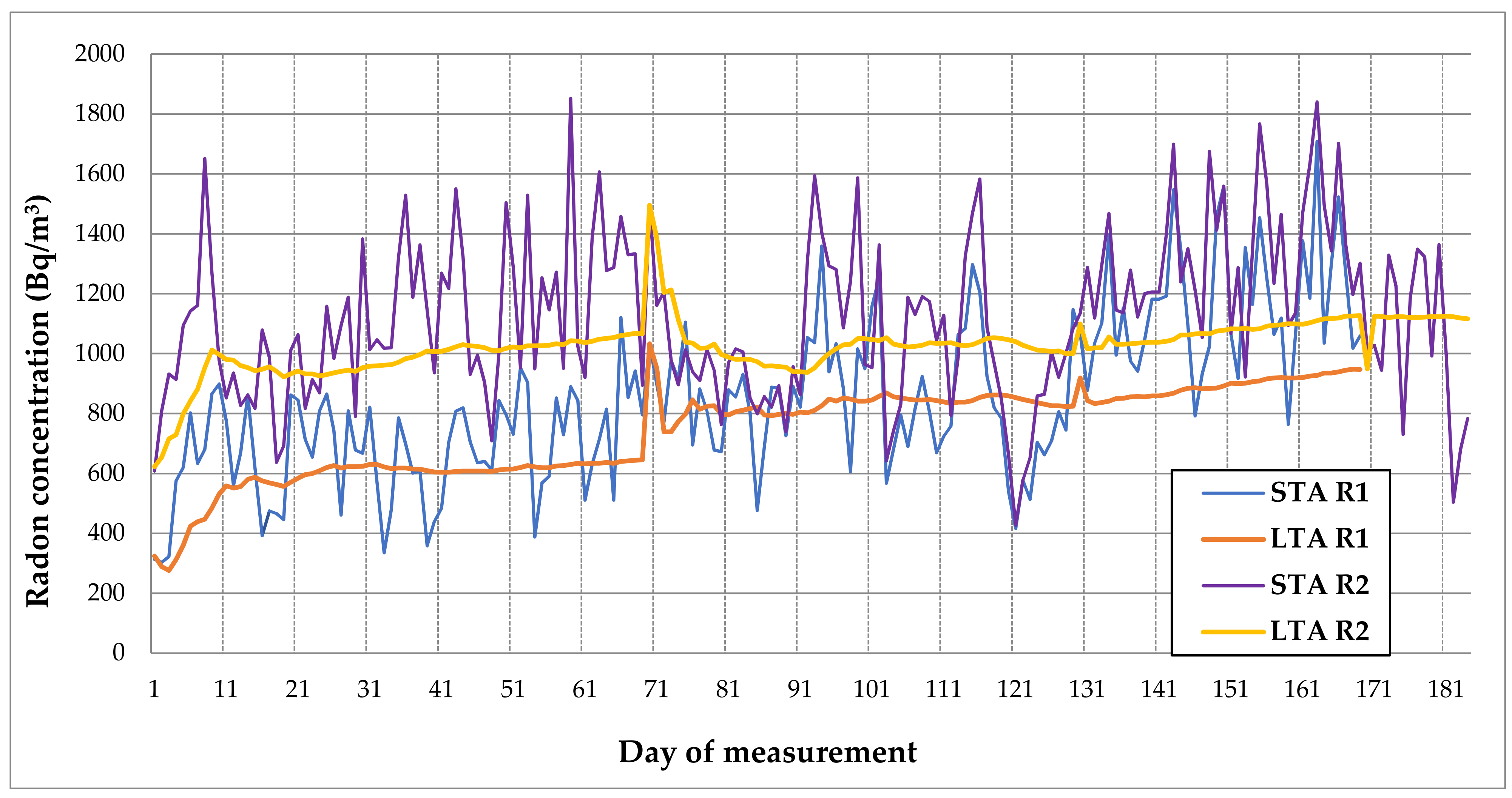
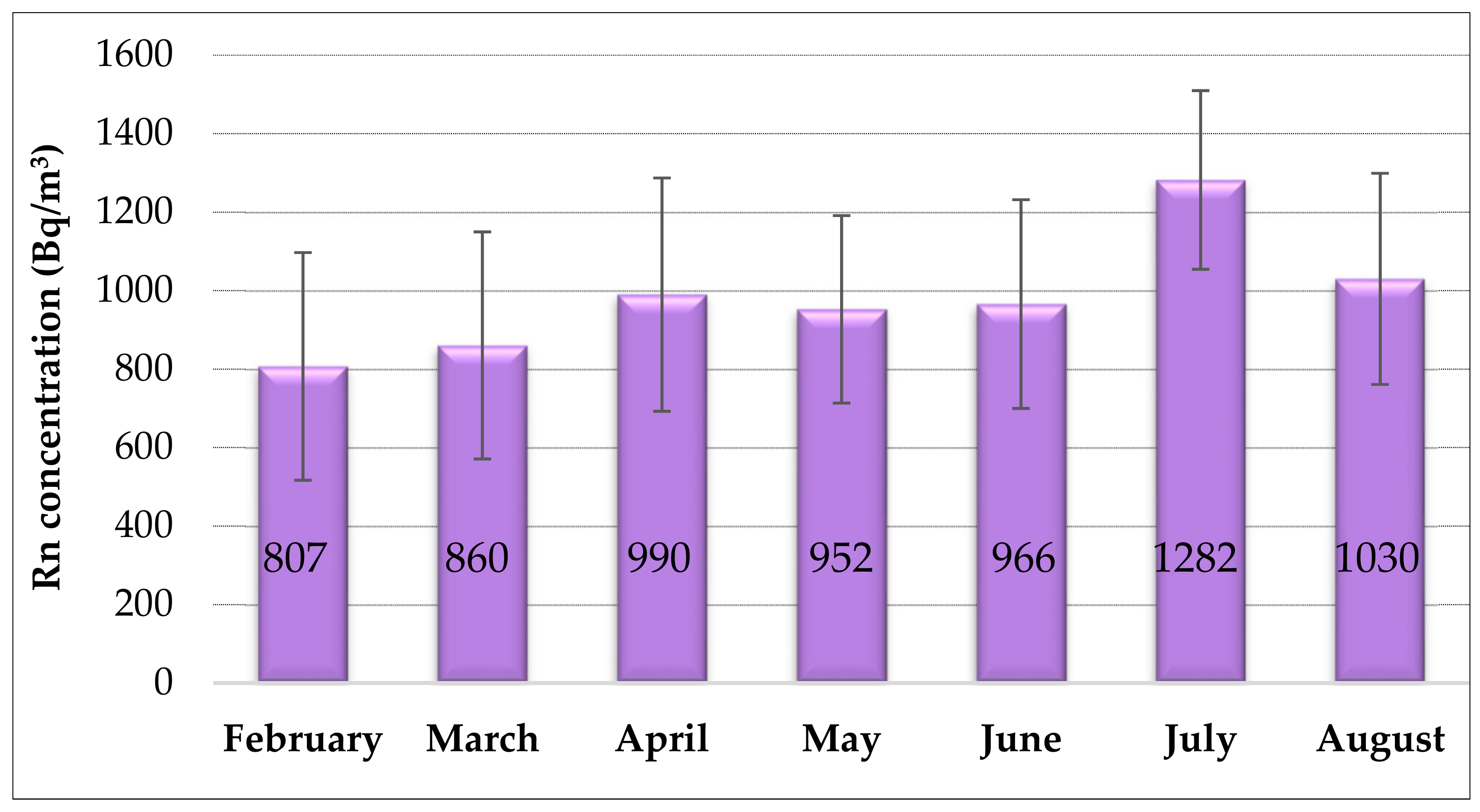
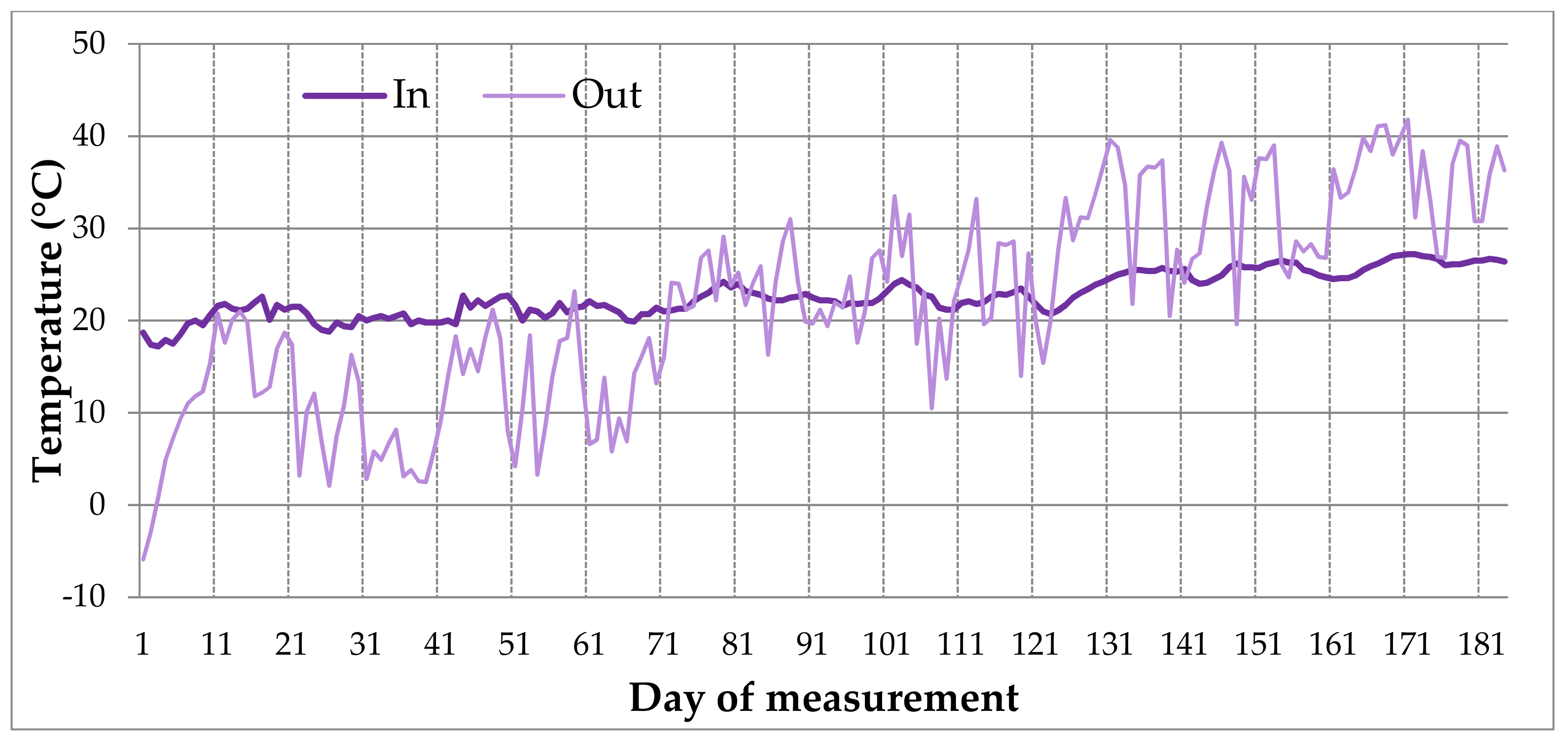
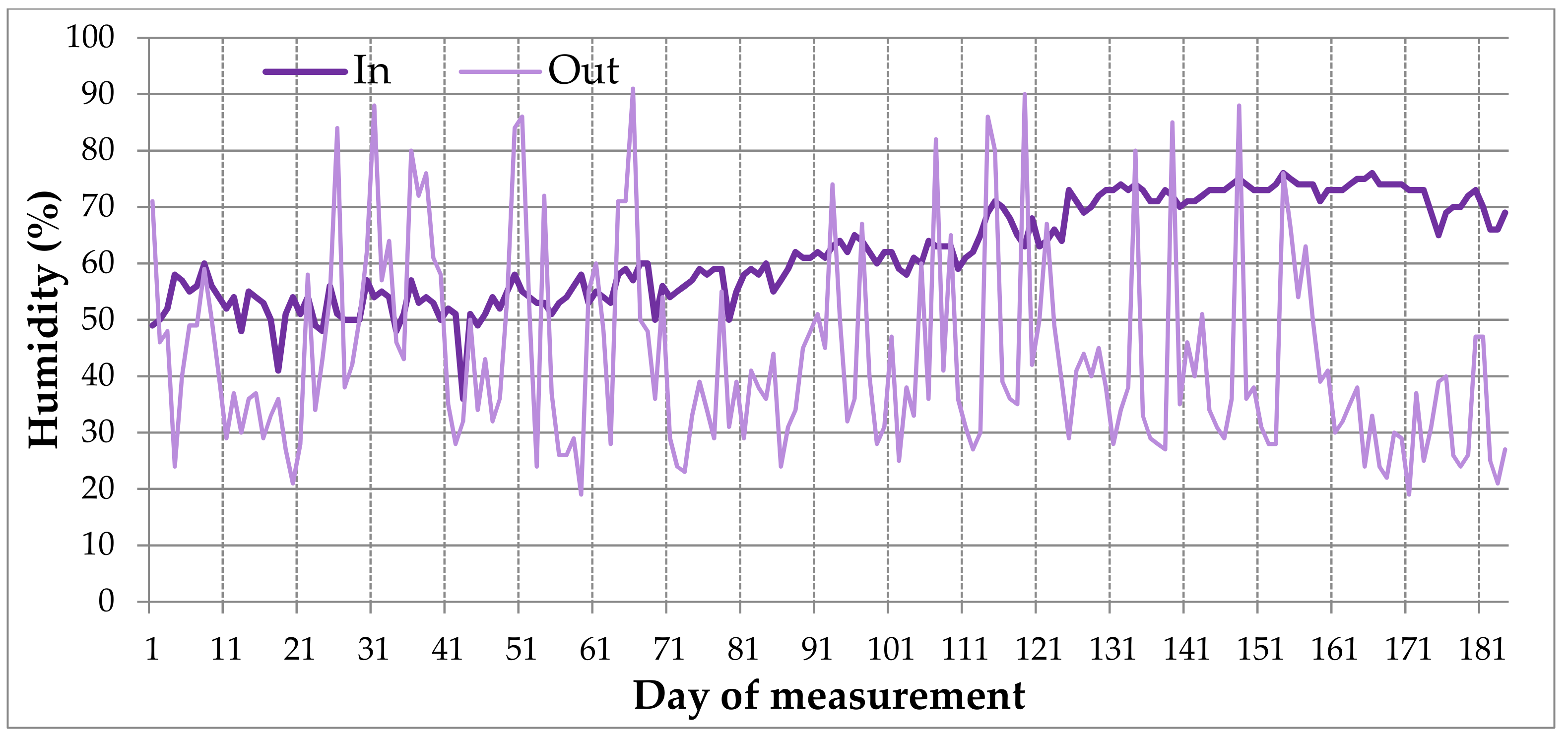
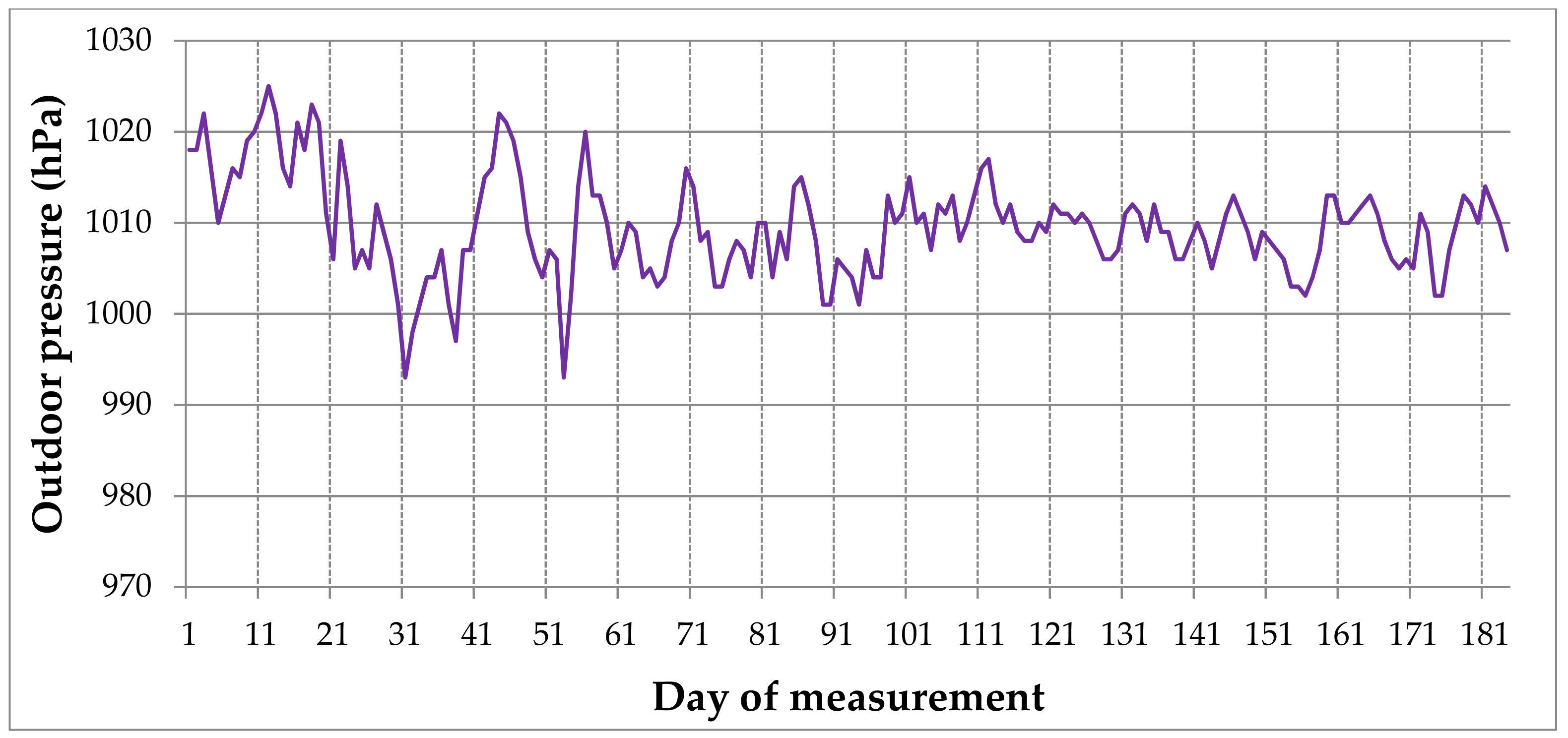
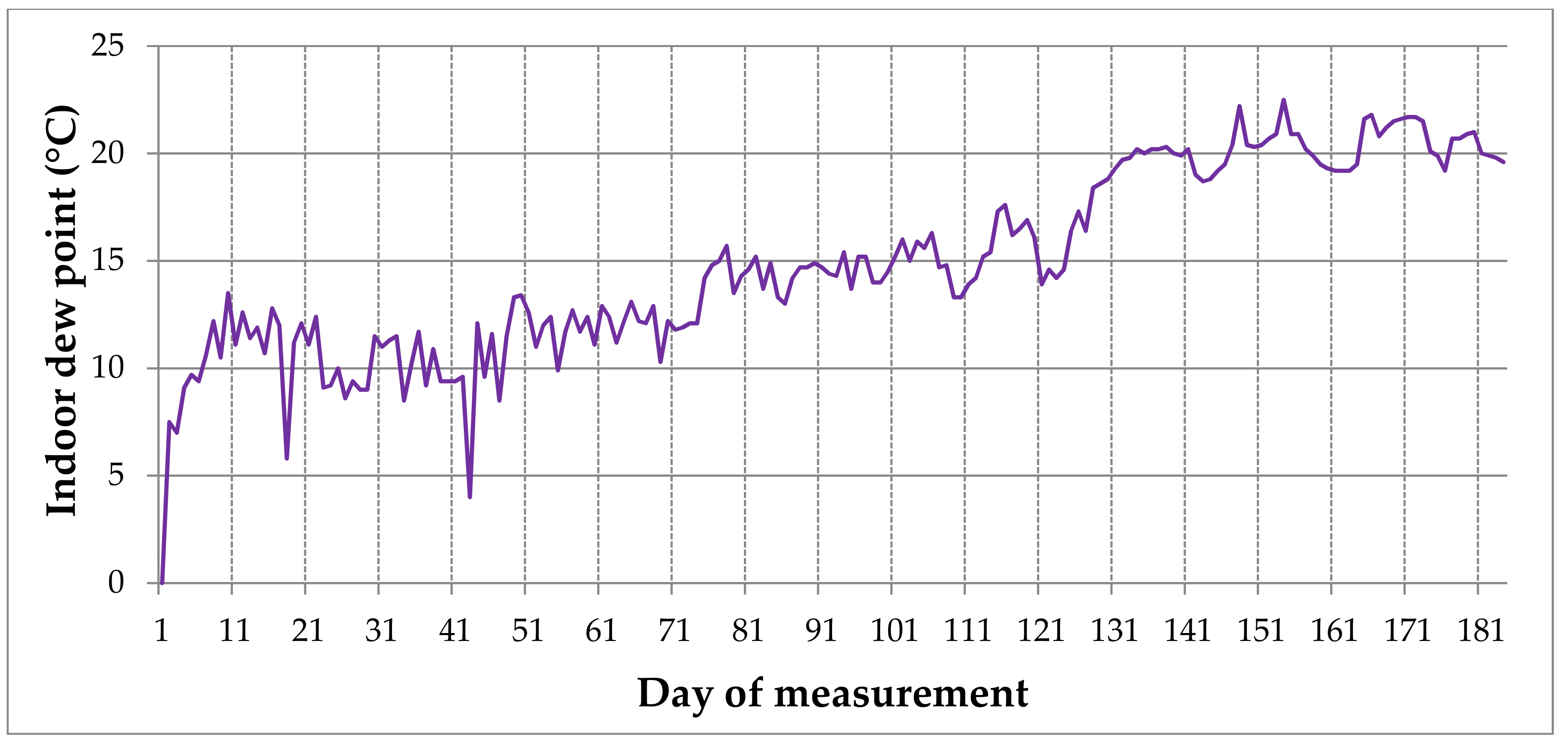
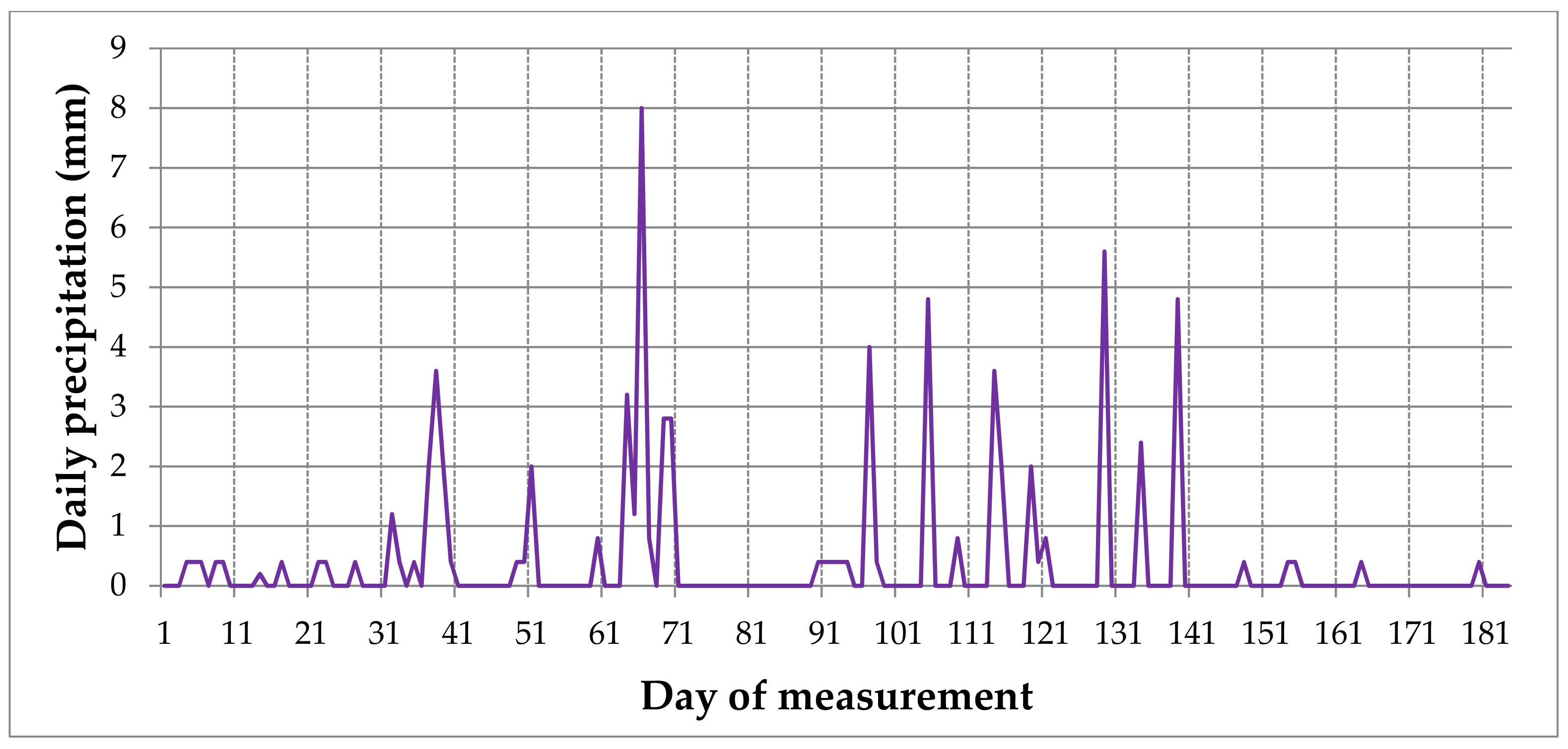
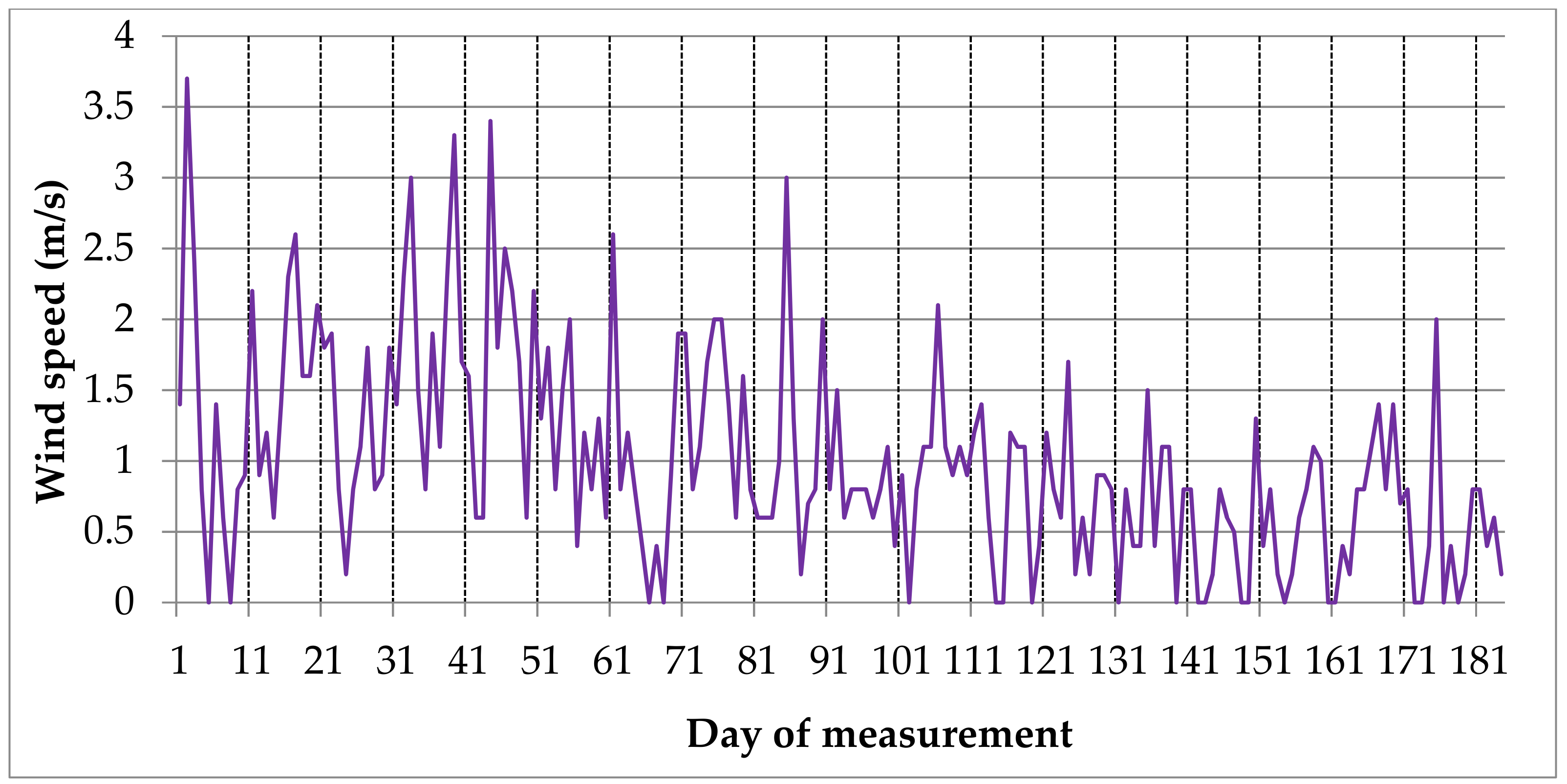
| Meteorological Parameter | Minimum | Maximum | Rn Concentration (Bq/m3)/Pearson Correlation Coefficient |
|---|---|---|---|
| Temperature (°C) indoors | 17.2 | 27.2 | 0.45 |
| Temperature (°C) outdoors | −5.9 | 41.8 | 0.40 |
| Temperature(°C) differences | −15 | 24.6 | −0.07 |
| Humidity (%) indoors | 36 | 76 | 0.56 |
| Humidity (%) outdoors | 19 | 91 | 0.03 |
| Humidity (%) differences | −34 | 56 | 0.30 |
| Pressure (hPa) outdoors | 993 | 1025 | −0.26 |
| Dew point (°C) indoors | 4 | 22.5 | 0.53 |
| Precipitation (mm) | 0 | 8 | 0.09 |
| Wind speed (m/s) | 0 | 3.7 | −0.41 |
Publisher’s Note: MDPI stays neutral with regard to jurisdictional claims in published maps and institutional affiliations. |
© 2022 by the authors. Licensee MDPI, Basel, Switzerland. This article is an open access article distributed under the terms and conditions of the Creative Commons Attribution (CC BY) license (https://creativecommons.org/licenses/by/4.0/).
Share and Cite
Spasić, D.; Gulan, L. High Indoor Radon Case Study: Influence of Meteorological Parameters and Indication of Radon Prone Area. Atmosphere 2022, 13, 2120. https://doi.org/10.3390/atmos13122120
Spasić D, Gulan L. High Indoor Radon Case Study: Influence of Meteorological Parameters and Indication of Radon Prone Area. Atmosphere. 2022; 13(12):2120. https://doi.org/10.3390/atmos13122120
Chicago/Turabian StyleSpasić, Dušica, and Ljiljana Gulan. 2022. "High Indoor Radon Case Study: Influence of Meteorological Parameters and Indication of Radon Prone Area" Atmosphere 13, no. 12: 2120. https://doi.org/10.3390/atmos13122120
APA StyleSpasić, D., & Gulan, L. (2022). High Indoor Radon Case Study: Influence of Meteorological Parameters and Indication of Radon Prone Area. Atmosphere, 13(12), 2120. https://doi.org/10.3390/atmos13122120






